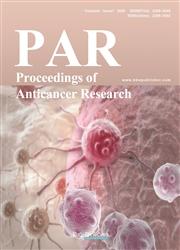Mechanism of SNHG12 in Regulating Human Angiostatin Binding Protein Through MicroRNA-497 in the Migration and Invasion of Human Lung Cancer Cells
引用次数: 0
Abstract
Objective: To investigate the effect of small nucleolar host gene 12 (SNHG12) on the migration and invasion of human lung cancer cells by regulating human angiostatin binding protein through microribonucleic acid (microRNA)-497. Methods: A549, H1299, and PC9 cells were cultured in Roswell Park Memorial Institute (RPMI)-1640 medium containing 10% fetal bovine serum, and human bronchial epithelial (HBE) cells were cultured in Dulbecco’s modified eagle medium (DMEM) containing 10% fetal bovine serum. The incubator conditions were as follows: saturated humidity, 37?, and 5% carbon dioxide (CO2). Results: The gene expressions of small nucleolar host gene 12 (SNHG12) in HBE, A549, H1299, and PC9 were 1.00 ± 0.02, 5.61 ± 0.42, 3.78 ± 0.29, and 3.51 ± 0.23, respectively. The gene expressions of microRNA-497HBE, A549, H1299, and PC9 were 1.00 ± 0.13, 0.21 ± 0.04, 0.35 ± 0.05, and 0.37 ± 0.06, respectively, with P < 0.05. The microRNA-497 gene expression and cell apoptosis rate in the microRNA-497 group and the microRNA-497 + pcDNA3.1 group were significantly higher than those in the miR-NC group, whereas the A value and cell invasion number were significantly lower than those in the miR-negative control (NC) group, with P < 0.05. Compared with the microRNA-497 + pcDNA3.1 group, the microRNA-497 gene expression and cell apoptosis rate in the microRNA-497 + SNHG12 group were significantly lower, whereas the A value and cell invasion number were significantly higher, with P < 0.05. Conclusion: SNHG12 can inhibit the migration and invasion of human lung cancer cells by regulating human angiostatin binding protein through microRNA-497.SNHG12通过微小RNA-497调节人血管抑素结合蛋白在人癌症细胞迁移和侵袭中的作用机制
目的:探讨小核仁宿主基因12 (SNHG12)通过微核糖核酸(microRNA)-497调控人血管抑制素结合蛋白对人肺癌细胞迁移和侵袭的影响。方法:A549、H1299和PC9细胞在含10%胎牛血清的Roswell Park Memorial Institute (RPMI)-1640培养基中培养,人支气管上皮细胞(HBE)在含10%胎牛血清的Dulbecco 's modified eagle培养基(DMEM)中培养。培养箱条件如下:饱和湿度,37?和5%的二氧化碳(CO2)。结果:小核仁宿主基因12 (SNHG12)在HBE、A549、H1299、PC9中的表达量分别为1.00±0.02、5.61±0.42、3.78±0.29、3.51±0.23。microRNA-497HBE、A549、H1299、PC9基因表达量分别为1.00±0.13、0.21±0.04、0.35±0.05、0.37±0.06,差异均有统计学意义,P < 0.05。microRNA-497组和microRNA-497 + pcDNA3.1组的microRNA-497基因表达量和细胞凋亡率均显著高于miR-NC组,而A值和细胞侵袭数均显著低于mir -阴性对照(NC)组,差异均有P < 0.05。与microRNA-497 + pcDNA3.1组相比,microRNA-497 + SNHG12组的microRNA-497基因表达量和细胞凋亡率显著降低,而A值和细胞侵袭数显著升高,差异均有P < 0.05。结论:SNHG12可能通过microRNA-497调控人血管抑制素结合蛋白,从而抑制人肺癌细胞的迁移和侵袭。
本文章由计算机程序翻译,如有差异,请以英文原文为准。
求助全文
约1分钟内获得全文
求助全文

 求助内容:
求助内容: 应助结果提醒方式:
应助结果提醒方式:


